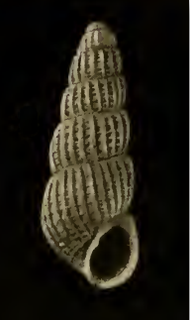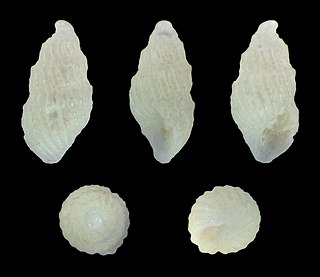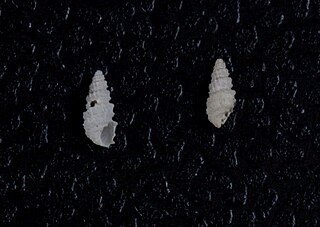Related Research Articles

Besla is a small genus of miniature sea snails, pyramidellid gastropod mollusks in the family Pyramidellidae within the tribe Chrysallidini.

Folinella is a genus of minute sea snails, pyramidellid gastropod mollusks or micromollusks in the family Pyramidellidae within the tribe Chrysallidini.
Gurmatia is an extinct small genus of pyramidellid gastropod mollusks or micromollusks in the family Pyramidellidae.
Hinemoa is a genus of small sea snails, pyramidellid gastropod mollusks. This genus is currently placed in the subfamily Chrysallidinae, within the family Pyramidellidae.

Odostomia is the most speciose genus of minute sea snails, pyramidellid gastropod mollusks. This genus is placed in the family Pyramidellidae in the subfamily Odostomiinae. There are several hundred species in this diverse genus
Ivara is a small genus of sea snails, pyramidellid gastropod mollusks or micromollusks. This genus is currently placed in the tribe Chrysallidini, of the family Odostomiidae. The Brazilian species have been revised by Pimenta et al. (2009). There are both living and fossil species in this genus.
Levipyrgulina is a small genus of very small sea snails, pyramidellid gastropod mollusks or micromollusks. This genus is currently placed in the subfamily Chrysallidinae of the family Odostomiidae.

Linopyrga is a small genus of very small sea snails, pyramidellid gastropod mollusks or micromollusks. This genus is currently placed in the subfamily Chrysallidinae of the family Odostomiidae.
Menesthella is a genus of very small sea snails, pyramidellid gastropod mollusks, or micromollusks. This genus is currently placed in the subfamily Chrysallidinae of the family Odostomiidae. It was originally described as a subgenus of Menestho Möller, 1842 but was erected to genus status by Schander et al. 1999.

Polemicella is a small genus of very small sea snails, pyramidellid gastropod mollusks or micromollusks. This genus is currently placed in the subfamily Chrysallidinae of the family Odostomiidae.
Siogamaia is a small genus of very small sea snails, pyramidellid gastropod mollusks or micromollusks. This genus is currently placed in the subfamily Chrysallidinae of the family Odostomiidae. The genus was originally described as a subgenus of Tropaeas Dall & Bartsch, 1904, but was later erected to a full genus and placed within Chysallidinae by Schander et al. (1999).
Waikura is a genus of very small sea snails, pyramidellid gastropod mollusks, or micromollusks. This genus is currently placed in the subfamily Chrysallidinae of the family Odostomiidae.
Pukeuria is a genus of very small sea snails, pyramidellid gastropod mollusks or micromollusks. This genus is currently placed in the subfamily Chrysallidinae of the family Odostomiidae.

Alvania gallinacea is a species of minute sea snail with an operculum, a marine gastropod mollusk or micromollusk in the family Rissoidae.

Boonea cincta is a species of sea snail, a marine gastropod mollusk in the family Pyramidellidae, the pyrams and their allies. The species is one of eleven known species within the Boonea genus of gastropods.

Odostomia callimorpha is a species of sea snail, a marine gastropod mollusc in the family Pyramidellidae, the pyrams and their allies.

Odostomia excisa is a species of sea snail, a marine gastropod mollusc in the family Pyramidellidae, the pyrams and their allies.
Pyrgulina densecostata is a species of very small sea snail, a pyramidellid gastropod micromollusk. This genus is currently placed in the subfamily Chrysallidinae of the family Pyramidellidae.

Odostomia trachis is a species of sea snail, a marine gastropod mollusc in the family Pyramidellidae, the pyrams and their allies.

Ividella navisa is a species of sea snail, a marine gastropod mollusk in the family Pyramidellidae, the pyrams and their allies. The species is one of a number within the genus Chrysallida.
References
- 1 2 Laws C. R. (1940). "The Waitotaran faunule at Kaawa Creek - Part 3". Transactions and Proceedings of the Royal Society of New Zealand . 69 (4): 427–447.